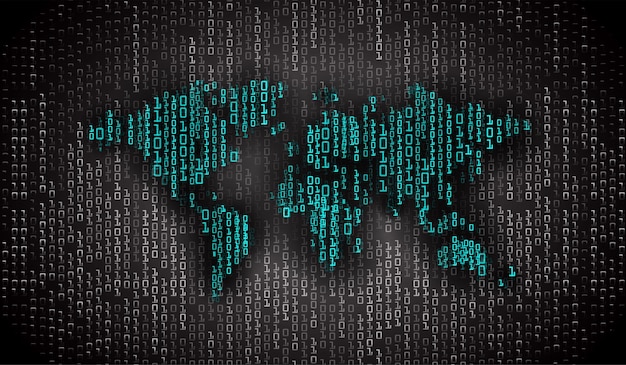US Cybersecurity Strategy: New Approaches to Global Threats

US Response to Global Cybersecurity Threats: New Strategies and Potential Outcomes involves a multi-faceted approach, including strengthening international partnerships, enhancing domestic infrastructure resilience, and developing proactive cyber defense capabilities to counter increasingly sophisticated cyberattacks.
The digital age has brought unprecedented convenience and connectivity, but it has also opened new avenues for malicious actors to exploit vulnerabilities. The US Response to Global Cybersecurity Threats: New Strategies and Potential Outcomes is critical in safeguarding national security, economic stability, and the privacy of its citizens. This article delves into the innovative approaches the US is adopting to counter these evolving threats.
Understanding the Evolving Landscape of Cybersecurity Threats
The cybersecurity landscape is constantly shifting, with threats becoming more sophisticated and pervasive. Understanding the nature of these threats is the first step in formulating effective responses.
Cyber threats can range from simple phishing attacks to complex, state-sponsored operations. These attacks can target critical infrastructure, government agencies, and private sector companies, causing significant disruption and financial losses. It’s crucial to stay ahead of these evolving tactics to maintain a robust defense.
Common Types of Cyber Threats
Several types of cyber threats pose significant risks to the US and its allies.
Ransomware Attacks
Ransomware attacks involve malicious software that encrypts a victim’s files, rendering them inaccessible until a ransom is paid. These attacks have become increasingly common and can cripple businesses and organizations.
State-Sponsored Hacking
State-sponsored hacking involves cyberattacks conducted by or on behalf of nation-states. These attacks are often aimed at stealing sensitive information, disrupting critical infrastructure, or spreading disinformation.
Supply Chain Attacks
Supply chain attacks target vulnerabilities in the software or hardware supply chain to compromise multiple organizations at once. These attacks can be particularly devastating due to their widespread impact.
- Identifying and mitigating vulnerabilities in software and hardware.
- Enhancing security protocols for third-party vendors.
- Implementing rigorous testing and monitoring procedures.
Understanding the nature and scope of these threats is crucial for developing effective cybersecurity strategies. By staying informed and proactive, the US can better protect itself from cyberattacks.

New Strategies in US Cybersecurity Response
To address the evolving threat landscape, the US is implementing new and innovative cybersecurity strategies. These strategies focus on enhancing resilience, strengthening partnerships, and proactively defending against cyberattacks.
These new strategies include improving threat intelligence sharing, developing advanced detection and response capabilities, and investing in cybersecurity workforce development. By taking a comprehensive approach, the US aims to stay ahead of its adversaries in the digital realm.
Enhancing Threat Intelligence Sharing
Effective cybersecurity requires timely and accurate threat intelligence. The US is working to enhance threat intelligence sharing among government agencies, private sector companies, and international partners.
This includes sharing information about emerging threats, vulnerabilities, and attack patterns. By pooling resources and expertise, the US can improve its ability to detect and respond to cyberattacks.
Developing Advanced Detection and Response Capabilities
Advanced detection and response capabilities are essential for identifying and mitigating cyber threats in real-time. The US is investing in technologies such as artificial intelligence and machine learning to enhance its detection capabilities.
This includes developing automated tools for analyzing network traffic, identifying anomalies, and responding to incidents. By leveraging these technologies, the US can improve its ability to defend against sophisticated cyberattacks.
- Investing in AI-driven threat detection tools.
- Developing automated incident response systems.
- Enhancing real-time monitoring and analysis capabilities.
The US is adopting a multi-faceted approach to address the ever-evolving cybersecurity landscape. These new strategies are essential for protecting critical infrastructure, government agencies, and private sector companies from cyberattacks.
The Role of Public-Private Partnerships
Public-private partnerships (PPPs) are critical in the US cybersecurity strategy. These partnerships leverage the expertise and resources of both the public and private sectors to enhance cybersecurity efforts.
By working together, government agencies and private companies can share threat intelligence, develop best practices, and coordinate incident response efforts. This collaborative approach is essential for defending against cyberattacks.
Benefits of Public-Private Partnerships
PPPs offer several benefits for enhancing cybersecurity.
Enhanced Threat Intelligence Sharing
PPPs facilitate the sharing of threat intelligence between government agencies and private companies. This allows organizations to stay informed about emerging threats and take proactive measures to protect their systems.
Development of Best Practices
PPPs enable the development of best practices for cybersecurity. By sharing knowledge and expertise, organizations can identify effective strategies for mitigating cyber risks.
Coordinated Incident Response Efforts
PPPs promote coordinated incident response efforts. In the event of a cyberattack, government agencies and private companies can work together to contain the damage and restore services.
- Encouraging information sharing and collaboration.
- Supporting the development of cybersecurity standards and guidelines.
- Promoting innovation in cybersecurity technologies and practices.
These partnerships are essential for defending against cyberattacks and ensuring the security of the nation’s digital infrastructure.

International Cooperation in Cybersecurity
Cybersecurity is a global challenge that requires international cooperation. The US is actively engaged in international efforts to combat cybercrime and promote cybersecurity.
This includes working with allies to share information, coordinate incident response, and develop international norms of behavior in cyberspace. By collaborating with other nations, the US can enhance its ability to defend against cyberattacks and promote a more secure digital environment.
Key Areas of International Cooperation
Several key areas of international cooperation are critical for addressing cybersecurity challenges.
Information Sharing
Sharing information about cyber threats and vulnerabilities is essential for enhancing global cybersecurity. The US is working with its allies to share threat intelligence and improve situational awareness.
Law Enforcement Cooperation
Law enforcement cooperation is critical for combating cybercrime. The US is working with international partners to investigate and prosecute cybercriminals. This includes extraditing cybercriminals and coordinating law enforcement operations.
Capacity Building
Capacity building involves helping other nations develop their cybersecurity capabilities. The US is providing technical assistance and training to help developing countries improve their cybersecurity posture.
- Promoting international norms of behavior in cyberspace.
- Strengthening cybersecurity capacity in developing countries.
- Fostering collaboration on cybersecurity research and development.
International cooperation is essential for addressing the global cybersecurity challenge. By working together, nations can enhance their ability to defend against cyberattacks and promote a more secure digital environment.
Legislative and Regulatory Frameworks
Legislative and regulatory frameworks play a crucial role in shaping the US cybersecurity landscape. These frameworks provide the legal and regulatory basis for cybersecurity activities and help to ensure accountability.
Key legislative and regulatory initiatives include the Cybersecurity Information Sharing Act (CISA), the National Institute of Standards and Technology (NIST) Cybersecurity Framework, and various sector-specific regulations. These initiatives aim to promote information sharing, establish cybersecurity standards, and protect critical infrastructure.
Key Legislative and Regulatory Initiatives
Several key legislative and regulatory initiatives are shaping the US cybersecurity landscape.
Cybersecurity Information Sharing Act (CISA)
CISA promotes the sharing of cyber threat information between government agencies and private companies. This helps organizations stay informed about emerging threats and take proactive measures to protect their systems.
NIST Cybersecurity Framework
The NIST Cybersecurity Framework provides a voluntary set of standards and best practices for managing cybersecurity risks. It helps organizations assess their cybersecurity posture, identify gaps, and implement effective controls.
Sector-Specific Regulations
Various sector-specific regulations, such as those for the financial services and healthcare industries, impose specific cybersecurity requirements on organizations. These regulations aim to protect sensitive information and ensure the security of critical infrastructure.
- Ensuring compliance with cybersecurity standards and regulations.
- Promoting accountability for cybersecurity incidents.
- Supporting the development of cybersecurity workforce skills.
These frameworks are essential for promoting a strong cybersecurity posture and protecting the nation’s digital infrastructure.
Future Trends and Challenges in Cybersecurity
As technology continues to evolve, the cybersecurity landscape will continue to change. It is important to anticipate future trends and challenges in order to develop effective strategies for addressing them.
Some of the key trends and challenges include the increasing sophistication of cyberattacks, the proliferation of Internet of Things (IoT) devices, and the growing skills gap in the cybersecurity workforce. By staying ahead of these trends, the US can better protect itself from cyber threats.
Key Trends and Challenges
Several key trends and challenges will shape the future of cybersecurity.
Increasing Sophistication of Cyberattacks
Cyberattacks are becoming increasingly sophisticated, making them harder to detect and defend against. This requires investing in advanced detection and response capabilities and promoting innovation in cybersecurity technologies.
Proliferation of Internet of Things (IoT) Devices
The proliferation of IoT devices is creating new attack vectors for cybercriminals. These devices often have weak security protections, making them vulnerable to exploitation. Securing IoT devices is a critical challenge for the future.
Growing Skills Gap in the Cybersecurity Workforce
There is a growing skills gap in the cybersecurity workforce, making it difficult to find qualified professionals to fill cybersecurity roles. Addressing this gap requires investing in cybersecurity education and training and promoting diversity in the cybersecurity workforce.
- Investing in cybersecurity research and development.
- Strengthening international partnerships to combat cybercrime.
- Promoting cybersecurity awareness and education.
By anticipating and addressing these trends and challenges, the US can continue to enhance its cybersecurity posture and protect itself from cyber threats.
| Key Aspect | Brief Description |
|---|---|
| 🛡️ Threat Intelligence | Sharing data on emerging cyber threats to enhance defense. |
| 🤝 Public-Private Partnerships | Collaboration between government and private sectors for robust cybersecurity. |
| 🌐 International Cooperation | Global efforts to combat cybercrime and promote cybersecurity norms. |
| 🔒 Legislative Frameworks | Legal and regulatory initiatives for cybersecurity activities and accountability. |
Frequently Asked Questions
▼
The main goal is to protect national security, economy and privacy from cyber threats by enhancing resilience and international cooperation.
▼
They enhance threat intel sharing, develop best practices, and coordinate incident response by combining resources and expertise.
▼
It helps in sharing info, coordinating responses, and establishing international norms, promoting a more secure global digital environment.
▼
It provides standards for managing cyber risks, helping organizations ensure cybersecurity standards and protect digital infrastructure.
▼
Challenges include sophisticated cyberattacks, IoT security, and skills gap. Addressing them involves research, partnerships, and education.
Conclusion
In conclusion, the US response to global cybersecurity threats requires a comprehensive and adaptive strategy. By enhancing threat intelligence, fostering public-private partnerships, promoting international cooperation, and strengthening legislative frameworks, the US can better protect its national interests and ensure a secure digital future.





